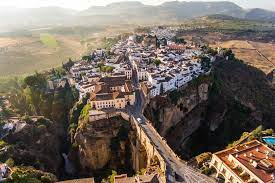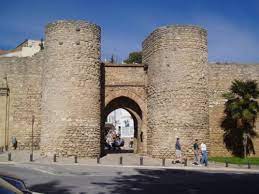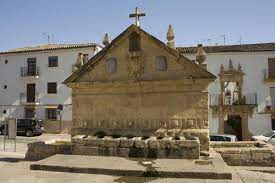A first impression of the City of Dreams
Pablo de Ronda wrote this article around 15 years ago when he first moved to Ronda, the main town of the Serrania de Ronda.
Being the grandson of a South Wales miner, he was more familiar with the Rhondda Valley until he discovered the Andalucían version. Hence the title of this article.
 As we turned the corner between two huge rocks, we glimpsed Ronda shimmering in the distance, white and bright atop its huge cliff. Moments later it disappeared from view, but then there it was again in all its glory as we drew nearer to our destination.
As we turned the corner between two huge rocks, we glimpsed Ronda shimmering in the distance, white and bright atop its huge cliff. Moments later it disappeared from view, but then there it was again in all its glory as we drew nearer to our destination.
Approaching this most impressive of the white towns in Andalucía from either the Costa del Sol or from Algeciras and Gibraltar is to marvel at its location and to be impressed by the ingenuity of the Moors who first established a settlement there 13 centuries ago.
Small wonder, then, that Ronda is part of the Grand Tour of Andalucía, along with Granada, Sevilla and Córdoba. Small wonder too that Ronda numbers amongst its 35 000 inhabitants as many as 656 foreign residents, according to the most recent census. As a resident myself now, it somehow doesn’t seem that many. Expats are there if you want them, but they are easily avoided.
The popularity of this town is demonstrated by the groups of day-trippers from the coast who wander the streets in their shorts and sandals, marvelling at the stunning architecture in the Old Moorish Quarter, staring unbelievingly into the deep gorge, el Tajo, that divides old Ronda from the new, and taking advantage of the wide range of shops at their disposal.
Occasionally, these visitors may wish they’d donned something warmer for Ronda is 723 metres above sea level and can be chilly and wet out of season. On such days the enterprising proprietors of the tourist shops do good business selling plastic macs and umbrellas.
 Arriving at the Almocábar gate on the southern edge of town you are in what was the old Moorish cemetery, now the up and coming San Francisco quarter. Walk through the gate and up the cobbled street via a short visit to the bell tower of the church of the Holy Spirit, Espíritu Santo, continue up the vehicle road for 100 metres before climbing the steps into Duquesa de la Parcent square, which is home to the delightful Town Hall and the intriguing architectural mix of the Cathedral Church of Santa María la Mayor.
Arriving at the Almocábar gate on the southern edge of town you are in what was the old Moorish cemetery, now the up and coming San Francisco quarter. Walk through the gate and up the cobbled street via a short visit to the bell tower of the church of the Holy Spirit, Espíritu Santo, continue up the vehicle road for 100 metres before climbing the steps into Duquesa de la Parcent square, which is home to the delightful Town Hall and the intriguing architectural mix of the Cathedral Church of Santa María la Mayor.
Head for the back right corner of the square and wander at random through the old Arab quarter with its magnificent mansions, palaces and tiny squares full of orange and lemon trees. Do not miss the Palacio de Mondragón with its delightful patios and gardens, which also houses the Municipal Museum. Also worth a visit is the Casa de Don Bosco, in honour of the canonised Italian priest St John Bosco, who never actually visited Ronda!
Emerging from the old quarter and turning left you find yourself on the 18th Century Puente Nuevo, the newest of three bridges joining the two halves of the town. The view from either side of the bridge is spectacular: to the west a fertile valley with a distant backdrop of brooding mountains; to the east deep cliff walls topped by hanging houses.
A trickle of water runs through the bottom of the gorge 130 metres below whilst hundreds of birds nest in the cliff faces. At dusk these rise into the air; among them Crag Martins, Pallid Swifts, Black Redstarts, Blue Rock Thrushes, Choughs, Griffon Vultures, Rock Doves and Blackcaps.
Beyond the modern and stylish Parador de Ronda, a luxury four-star hotel, you find yourself at one of the oldest and most beautiful of Spain’s bullrings. Ronda is the home of modern bullfighting, which was developed by one Pedro Romero born 252 years ago in the town. Built in 1785 it boasts the largest bullfighting arena in the world, yet has one of the smallest crowd capacities. Tickets for the infrequent bullfights held here are very difficult to come by. Nevertheless, the Plaza de Toros is open to the public and houses an interesting museum about bullfighting.
 Away from the bullring and back down the northern side of the Tajo you come to the Fountain of the Eight Spouts, Fuente de los Ocho Caños, before crossing the Roman bridge back to the other side, and climbing through the Arco de Felipe V, the Arch of Philip V.
Away from the bullring and back down the northern side of the Tajo you come to the Fountain of the Eight Spouts, Fuente de los Ocho Caños, before crossing the Roman bridge back to the other side, and climbing through the Arco de Felipe V, the Arch of Philip V.
This whole area was used as the location for the 1984 film of the opera Carmen, starring a very young Placido Domingo.
A brief detour down the hill takes the visitor to the Arab Baths, Baños Árabes, which are a delight. Recently restored the tour includes a film presentation (also in English) about the history of Ronda dating back to Roman times.
Back up the hill and you come to the Casa del Rey Moro and the Water Mines. Climb down 365 steps hewn from the interior of the cliff to the bottom of the gorge to see where the Arabs used to ‘mine’ their water and transport it up to the town above. On resurfacing you can get your breath back in the beautiful gardens.
After all this sightseeing it’s time for something to eat and drink; the choice is amazing. There are innumerable bars and restaurants where you can nibble on the wide variety of tapas, sit down for a reasonably priced and wholesome three-course menu of the day for about £6 sterling, or, if you want to, splash out on an a-la-carte meal.
Specialities of the region include cured ham, bull’s tail, suckling pig, wild boar, rabbit, goat and other game dishes. For vegetarians there are interesting choices such as fried aubergines in honey, wild asparagus and a wide range of tasty salads.
Ronda, traditional Spain at its best. As a taxi driver in another part of Spain once told me: “Aaa, Ronda, un sitio para volver” – a place to return to over and over again. That’s what I did and Ronda never disappointed. Now I live in the area full time, but that’s another story ...
Pablo de Ronda (aka Paul Whitelock) lives in the Serranía de Ronda. A former UK languages teacher and Ofsted school inspector, Pablo is now retired and runs a local holiday website, A1-HOLIDAYS.NET and an information website HELP-ME-RONDA.COM. He is also a sometime property developer, gardener, DIY-er and prolific blogger. He can be contacted at paulwhitelock@hotmail.com or on +34 636 52 75 16.